The posting below by Bruno Jacobs’ discussion on Achaemenid Rule in the Caucasus was originally published in the Encyclopedia Iranica on August 15, 2006. Kindly note that the pictures/illustrations and their accompanying descriptions do not appear in the original Encyclopedia Iranica article.
=========================================================================
Achaemenid rule in the Caucasus region was established, at the latest, in the course of the Scythian campaign of Darius I in 513-12 BCE. The Persian domination of the cis-Caucasian area (the northern side of the range) was brief, and archeological findings indicate that the Great Caucasus formed the northern border of the empire during most, if not all, of the Achaemenid period after Darius.
After the conquest of Armenia (OPers. Armina), which is recorded as a province (OPers. dahyu-) of the Achaemenid empire in the Bisotun inscription, the realm of Cyrus the Great already must have reached considerably to the north. The Little Caucasus, the line of the Phasis/Rion and Cyrus/Kura rivers, and the Great Caucasus all offer themselves as natural frontiers, but it is not possible to reconstruct in more detail the boundary line of that time.
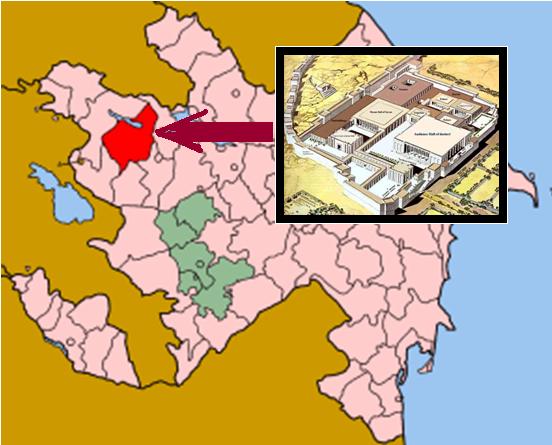 An Iranian legacy in the Caucasus. To the south of the Republic of Georgia is Shamkhir located in the Republic of Azarbaijan (ROA) (known as Arran until 1918). Shamkhir is located some 350 kilometres west of Baku near the Armenian border to its west. The CAIS website hosted by Shapur Suren-Pahlav reported on August 28, 2007 that Archaeologists from the ROA, Georgia and Germany unearthed ruins of a monument dated to the Achaemenid dynasty in the town of Shamkhir. The head of the archaeology team stated that: “During the excavation, we found traces of a 2500 year old historical structure…which has one 1000 square meter chamber surrounded by several smaller rooms…The ruins indicate that this area was once an important Achaemenid centre in the northern provinces in the Caucasus” (Picture and caption from Kaveh Farrokh’’s lectures at the University of British Columbia’s Continuing Studies Division and were also presented at Stanford University’s WAIS 2006 Critical World Problems Conference Presentations on July 30-31, 2006).
An Iranian legacy in the Caucasus. To the south of the Republic of Georgia is Shamkhir located in the Republic of Azarbaijan (ROA) (known as Arran until 1918). Shamkhir is located some 350 kilometres west of Baku near the Armenian border to its west. The CAIS website hosted by Shapur Suren-Pahlav reported on August 28, 2007 that Archaeologists from the ROA, Georgia and Germany unearthed ruins of a monument dated to the Achaemenid dynasty in the town of Shamkhir. The head of the archaeology team stated that: “During the excavation, we found traces of a 2500 year old historical structure…which has one 1000 square meter chamber surrounded by several smaller rooms…The ruins indicate that this area was once an important Achaemenid centre in the northern provinces in the Caucasus” (Picture and caption from Kaveh Farrokh’’s lectures at the University of British Columbia’s Continuing Studies Division and were also presented at Stanford University’s WAIS 2006 Critical World Problems Conference Presentations on July 30-31, 2006).
In the classical sources referring to the Achaemenid period, the Caucasus region is widely neglected (Lordkipanidze, 2000, pp. 4-7). So historians felt obliged to speculate about the border of the empire in that region during the approximately 200 years of Achaemenid rule that followed. Hewsen (1983, p. 128) expresses doubts that the Achaemenid empire ever extended beyond the Armenian plateau. Lordkipanidze (2000, pp. 9-11) concedes that Kachetia may have belonged to the Persian empire, but not Caucasian Iberia north of the Kura. Gagoshidze (1996, pp. 125 f.), however, is of the opinion that the territory of modern Georgia as a whole belonged to the Achaemenid empire, perhaps as an autonomous region (also Knauss, 1999b, p. 220).
It is not possible to reach a definite conclusion on the incorporation of areas between the Black and the Caspian Seas into the empire during the time of Darius I on the basis of Herodotus’s so-called “satrapy list” (Hdt., 3.90-94, esp. 93-94), as is done by Hewsen (1983, pp. 125 f.) and Ter-Martirosov (2000, pp. 246-50), because this catalogue is not appropriate either for the reconstruction of the imperial administration or for historical geography. Clearer insights are gained from the Scythian campaign of Darius I in 513-12 BCE, which involved military operations in the Caucasus region and the territory north of it.
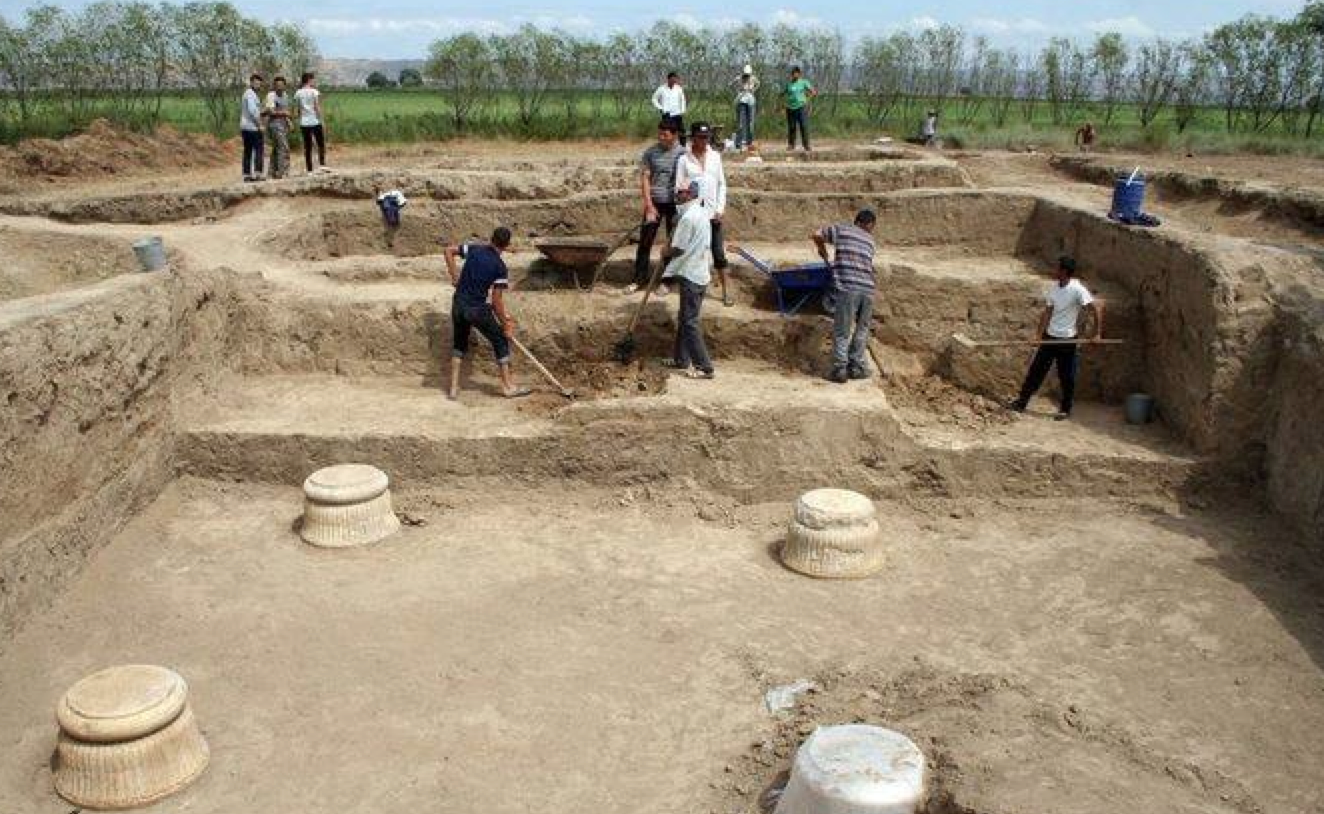 Excavation of the Achaemenid building at Qarajamirli. The researchers Babaev, Gagoshidze, Knauß and Florian in 2007 (An Achaemenid “Palace” at Qarajamirli (Azerbaijan) Preliminary Report on the Excavations in 2006. Ancient Civilizations from Scythia to Siberia, Volume 13, Numbers 1-2,, pp. 31-45(15)) discovered the remains of a monumental building as well as a number of fragments of limestone column bases. This follows closely the plan of an Achaemenid palace featuring a Symmetrical ground plan for the building as well as architectural sculpture. The pottery found on floor closely follow Persian models from the Achaemenid era. Similar structures have been excavated from Sary Tepe (Republic of Azerbaijan) and Gumbati (Georgia). The Sary Tepe, Gumbatii and Qarajamirli buildings can be interpreted as residences of Persian officials who left the region when Achaemenid Empire collapsed.
Excavation of the Achaemenid building at Qarajamirli. The researchers Babaev, Gagoshidze, Knauß and Florian in 2007 (An Achaemenid “Palace” at Qarajamirli (Azerbaijan) Preliminary Report on the Excavations in 2006. Ancient Civilizations from Scythia to Siberia, Volume 13, Numbers 1-2,, pp. 31-45(15)) discovered the remains of a monumental building as well as a number of fragments of limestone column bases. This follows closely the plan of an Achaemenid palace featuring a Symmetrical ground plan for the building as well as architectural sculpture. The pottery found on floor closely follow Persian models from the Achaemenid era. Similar structures have been excavated from Sary Tepe (Republic of Azerbaijan) and Gumbati (Georgia). The Sary Tepe, Gumbatii and Qarajamirli buildings can be interpreted as residences of Persian officials who left the region when Achaemenid Empire collapsed.
At that time Darius attacked the Scythians in a “pincer” movement with two battalions, one coming from the west after the crossing of the Bosporus and Danube, and the other passing over the Caucasus and invading the region north of the Pontus from the east (Jacobs, 2000, pp. 95-99). In spite of the sophisticated tactics, the undertaking did not succeed, and both armies had to retreat—the western one across the Danube and the eastern one across the Oarus, which the Persians secured with fortresses (Hdt., 4.124) in order to save at least a limited territorial gain. Herodotus (4.123) tells us that the Oarus empties into Lake Maietis/Sea of Azov; only the Sal River can be identified with the Oarus, because this river joins the Tanais/Don shortly before it empties into the Sea of Azov (Haussig apud Horneffer et al., 1963, p. 694, n. 120). How far the Persian rule in cis-Caucasia extended to the east is completely uncertain. After the conquest, the region must have been included as an administrative sub-unit (Colchis) of the satrapy of Armenia (Jacobs, 1994, p. 184). Reports of the plans of operation formulated by the Scythians and Lacedaemonians against the Achaemenid empire may belong to this same period when the cis-Caucasian territories were under Persian rule: the Lacedaemonians planned to invade Asia Minor starting from Ephesus, while the Scythians were to attack Media following the Phasis (Hdt., 6.84).
Certainly the occupation of cis-Caucasia as well as the Thracian territory was short-lived. The exact time it ended is unknown. Possibly the repercussions from the defeat of the Persians in Greece and from the successful rebellion of the Thracians were also felt on the east side of the Sea of Azov. A corresponding retaliation on the side of the Scythians could have chased out the Persians, resulting in the displacement of the border to the south. Herodotus’s claim (3.97) that the empire’s border was formed by the Caucasus—by this he probably means the Great Caucasus—may refer to this period.
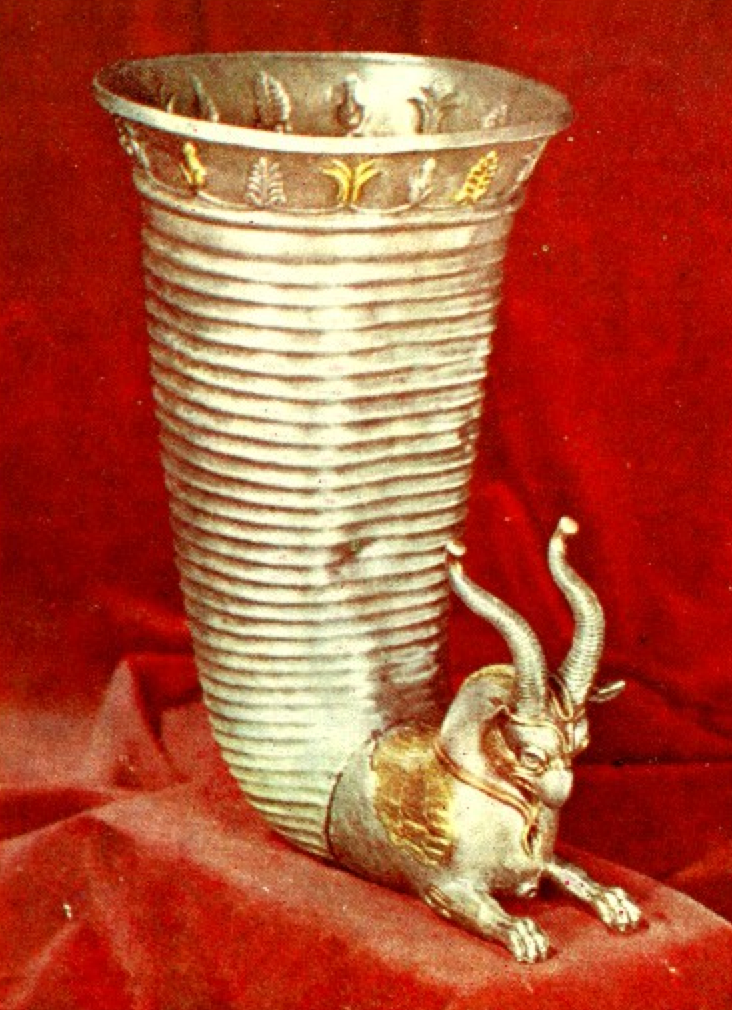 A Silver Rhython of the Achaemenid type from Yerznka, Armenia (5th Century BCE) (Source: Public Domain).
A Silver Rhython of the Achaemenid type from Yerznka, Armenia (5th Century BCE) (Source: Public Domain).
A clue to the contours of the border in later times is given by Xenophon in his report on the return of the “10,000” after the battle of Cunaxa. Marching in the direction of the Black Sea coast, the Greeks passed close by the territory of the Colchians, the border of which could not have run far to the east of Trapezous/Trabzon. Nothing indicates that the Greeks, at that point, might have been near the border of the realm (Xen., Anabasis 4.8). On the contrary, the Colchians were settling on imperial territory; and, since their estates, as Herodotus and others relate, were situated at the Phasis, the river could not have marked the border; thus the next natural barrier to the north, i.e., the Great Caucasus, recommends itself as the border of the empire (Hdt., 4.37; cf. 1.2 and 104; Nonnos, 13.248-52; Strabo, 11.2.17
The altogether sparse written sources are supplemented by the strikingly rich archeological evidence from the region south of the Great Caucasus. The quantity of Persian objects of luxury is considerable (Smirnov, 1934, pls. 3.24-25; 8-11; 61-65; Gagoshidze, 1964, pl. 12.74; idem, 1996, pp. 126 f.; Davlianidze, 1976; see also the glass bowls from Sairche and from the Algeti valley in Makharadze and Saginašvili, 1999; Gagoshidze and Saginašvili, 2000, p. 72, fig. 3). However, these do not necessarily signify political sovereignty of the Persians, because it is rarely possible to decide whether they document Persian presence, or bear witness to commercial relations, or reached the area as diplomatic presents. Also, local imitations of sumptuous tableware from Persia (Furtwängler, 1995, pp. 195-203, figs. 13.3, 15.6, 17.8; Gagoshidze, 1996, pp. 127 ff.) may point only to the influence of Persian prototypes exerted across the frontier.
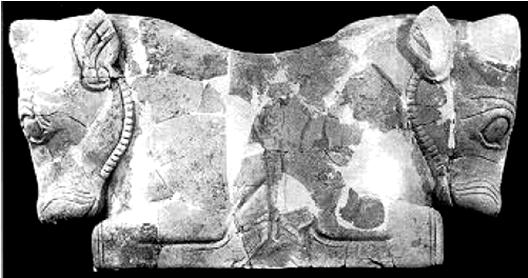 Ancient Georgian Column Capital discovered in Tsikha Gora (Courtesy of Gagoshidze and Kipiani). Note the striking resemblance to the column capital from Persepolis below (Picture and caption from Kaveh Farrokh’s lectures at the University of British Columbia’s Continuing Studies Division, Stanford University’s WAIS 2006 Critical World Problems Conference Presentations on July 30-31, 2006, University of Southern California and the University of Yerevan (Iranian Studies Department).
Ancient Georgian Column Capital discovered in Tsikha Gora (Courtesy of Gagoshidze and Kipiani). Note the striking resemblance to the column capital from Persepolis below (Picture and caption from Kaveh Farrokh’s lectures at the University of British Columbia’s Continuing Studies Division, Stanford University’s WAIS 2006 Critical World Problems Conference Presentations on July 30-31, 2006, University of Southern California and the University of Yerevan (Iranian Studies Department).
The case of architecture is entirely different; it reflects the influence of the Achaemenid residence with an intensity that is hardly imaginable without Persian presence during a longer period. This opinion is not so much based on the ground plans of buildings, because these either cannot be determined with certainty (Sari-Tepe: Knauss, 1999a, p. 96; cf. Kipiani, 1993, pl. I) or are only partially preserved (Gumbati: Furtwängler and Knauss, 1996, pp. 367-76, fig. 4; Knauss, 1999a, pp. 86-92). More instructive is the formation of individual architectural elements, particularly column bases and capitals, in the region of modern Georgia and through Armenia to Azerbaijan. Here we can mention: (1) a capital with antithetic bull protomes from Zichia Gora and a fragment of a bell-shaped column base that presumably belongs with it (Kipiani, 1993, p. 62, pls. II-V; Lordkipanidze, 1991, p. 152, pl. 40.2-3; Zkitischwili, 1995, pp. 88 f. figs. 5-6; Gagoshidze, 1996, pp. 132 f., fig. 4; Gagoshidze and Kipiani, 2000, pp. 62-64 figs. 1,7-8; 2-3); (2) fragments of another capital with bull protomes from Sairche (Kipiani, 1987, p. 63, pls. VI-IX; Gagoshidze, 1996, p. 133, fig. 5,, pl. 13.2); (3) fragments of at least six bell-shaped column bases from Gumbati (Furtwängler, 1995, pp. 188-94, figs. 10-11; Furtwängler and Knauss, 1996, pp. 374-76; Knauss, 1999a, p. 90; idem, 2000, pp. 121-27, figs. 3-4.2); (4) column bases and similar fragments from Benjamin (Zardarian and Akopian, 1994, p. 185, fig. 6; Gagoshidze and Kipiani, 2000, p. 60, fig. 1.5), Sari Tepe (Kipiani, 1987, pp. 72 f., pls. I-VII, XV f.; Gagoshidze and Kipiani, 2000, fig. 11), and Qaracamirli Köyi (Furtwängler and Knauss, 1996, pp. 374-76, fig. 9; Gagoshidze and Kipiani, 2000, fig. 1.6). This evidence supports the assumption that the region belonged to the Achaemenid empire for a longer period and testify to the orientation of the ruling class toward the forms of representation originating from the center of the empire.
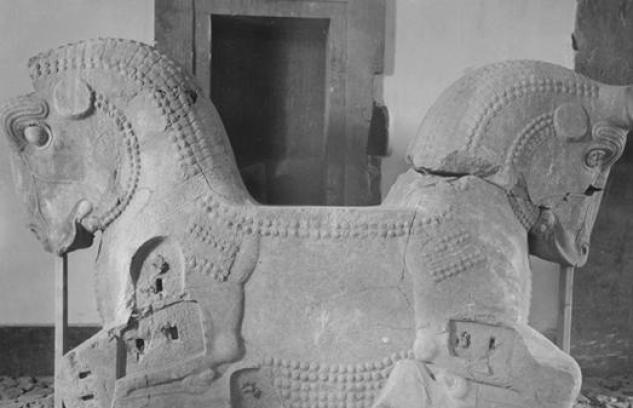 The double-bull motif column capital typical of Achaemenid-era architecture in sites such as Persepolis and Susa. Note the vivid parallels in style, construction and motifs to its Georgian counterpart shown further above. Architecture is only one of the many facets in which the ancient Caucasus and Persia have enjoyed mutual influences (Picture and caption from Kaveh Farrokh’s lectures at the University of British Columbia’s Continuing Studies Division, Stanford University’s WAIS 2006 Critical World Problems Conference Presentations on July 30-31, 2006, University of Southern California and the University of Yerevan (Iranian Studies Department).
The double-bull motif column capital typical of Achaemenid-era architecture in sites such as Persepolis and Susa. Note the vivid parallels in style, construction and motifs to its Georgian counterpart shown further above. Architecture is only one of the many facets in which the ancient Caucasus and Persia have enjoyed mutual influences (Picture and caption from Kaveh Farrokh’s lectures at the University of British Columbia’s Continuing Studies Division, Stanford University’s WAIS 2006 Critical World Problems Conference Presentations on July 30-31, 2006, University of Southern California and the University of Yerevan (Iranian Studies Department).
Bibliography
Abbreviation. AMIT – Archäologische Mitteilungen aus Iran und Turan.
Ts. Davlianidze, Adreantikuri khanis dzeglebi kvemo kartlidan (Early antique monuments in Kvemo Kartli), Skartvelos sakhelmtsipo museumis moambe 32-B, T’bilisi, 1976, pp. 118-47. A. E. Furtwängler, “Gumbati. Archäologische Expedition in Kachetien. 1. Vorbericht,” Eurasia Antiqua 1, 1995, pp. 177-211.A. E. Furtwängler and F. S. Knauß, “Gumbati. Archäologische Expedition in Kachetien. 2. Vorbericht,” Eurasia Antiqua 2, 1996, pp. 363-81. J. Gagoshidze, Adreantikuri khanis dzeglebi ksnis kheobidan (Early antique monuments from the Ksani valley), T’bilisi, 1964. Idem, “The Achaemenid Influence in Iberia,” Boreas 19, 1996, pp. 125-36. J. Gagoshidze and G. Kipiani, “Neue Beobachtungen zur achaimenidischen Baukunst in Kartli,” AMIT 32, 2000, pp. 59-65. J. Gagoshidze and M. Saginašvili, “Die achaimenidischen Glasgefäße aus Georgien,” AMIT 32, 2000, pp. 67-73. R. H. Hewsen, “Introduction to Armenian Historical Geography – II. The Boundaries of Achaemenid ‘Armina’,” REArm. 17, 1983, pp. 123-43. A. Horneffer, W. Haussig, and W. F. Otto, Herodot – Historien, Stuttgart, 1963. B. Jacobs, Die Satrapienverwaltung im Perserreich zur Zeit Darius’ III., Beihefte zum TAVO Reihe B Nr. 87, Wiesbaden, 1994. Idem, “Achaimenidenherrschaft in der Kaukasus-Region und in Cis-Kaukasien,” AMIT 32, 2000, pp. 93-102.
G. Kipiani, Kapiteli, T’bilisi, 1987 (Georgian with Russian summary). Idem, Arkhitektura Grusii antichnovo perioda – Arkhitekturnyie detali (The architecture of Georgia in the ancient period – architectural details), T’bilisi, 1993 (Georgian with Russian summary). F. S. Knauss, “Achämeniden in Transkaukasien,” in S. Lausberg and K. Oekentorp, eds., Fenster zur Forschung – Museumsvorträge der Museen der Westfälischen Wilhelms-Universität Münster, Worte – Werke – Utopien, Thesen und Texte Münsterscher Gelehrter 9, Münster, 1999a, pp. 81-114. Idem, “Ein silbernes Trinkhorn aus Mtisdziri – Die Kolchis zwischen Achämeniden und Griechen,” in R. F. Docter and E. M. Moormann, eds., Classical Archaeology towards the Third Millennium: Reflections and Perspectives. Proceedings of the XVth International Congress of Classical Archaeology, Amsterdam, July 12-17, 1998, Allard Pierson Series, Amsterdam, 1999b, pp. 218-22. Idem, “Der ‘Palast’ von Gumbati und die Rolle der Achaimeniden im transkaukasischen Iberien,” AMIT 32, 2000, pp. 119-30. O. Lordkipanidze, Archäologie in Georgien – Von der Altsteinzeit zum Mittelalter, Quellen und Forschungen zur Prähistorischen und Provinzialrömischen Archäologie 5, Weinheim, 1991. Idem, “Introduction to the History of Caucasian Iberia and its Culture of the Achaemenid and Post-Achaemenid Periods,” AMIT 32, 2000, pp. 3-19. G. Makharadze and M. Saginashvili, “An Achaemenian Glass Bowl from Sairkhe, Georgia,” Journal of Garden History 41, 1999, pp. 11-7. I. I. Smirnov, Der Schatz von Achalgori, T’bilisi, 1934. F. I. Ter-Martirosov, “Die Grenzen der achaimenidischen Gebiete in Transkaukasien,” AMIT 32, 2000, pp. 243-52. M. H. Zardarian and H. P. Akopian, “Archaeological Excavations of Ancient Monuments in Armenia 1987-1990,” Ancient Civilizations from Scythia to Siberia 1, 1994, pp. 161-93. G. Zkitishwili, “Der frühhellenistische Feuertempel von Kawtishkewi,” Archäologischer Anzeiger, 1995, pp. 83-98.



